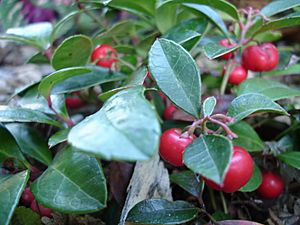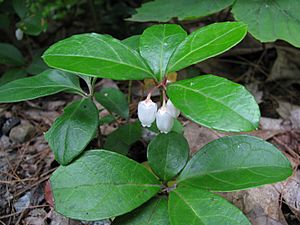Eastern teaberry facts for kids
Quick facts for kids Eastern teaberry |
|
|---|---|
 |
|
| The ripe berries in October in Hammond, Indiana | |
| Scientific classification | |
| Genus: |
Gaultheria
|
| Species: |
procumbens
|
Gaultheria procumbens, often called the eastern teaberry or American wintergreen, is a cool plant found in northeastern North America. It grows from Newfoundland all the way west to southeastern Manitoba, and south to Alabama. This plant is part of the Ericaceae family, which also includes heaths and blueberries.
Contents
What it Looks Like and Where it Grows
The eastern teaberry is a small, low-growing shrub. It usually reaches about 10 to 15 centimeters (4 to 6 inches) tall. Its leaves stay green all year, which is why it's called "evergreen." They are oval-shaped, about 2 to 5 cm (1 to 2 inches) long, and have a strong, fresh scent like oil of wintergreen.
Flowers and Fruit
The plant's flowers hang downwards and are white, sometimes with a hint of pink. They are shaped like bells, about 8 to 10 millimeters (0.3 to 0.4 inches) long. These flowers usually grow one to three per stem, tucked near the leaves. The parts inside the flower that hold pollen, called anthers, look a bit like a snake's tongue.
The fruit is bright red and about 6 to 9 mm (0.2 to 0.4 inches) across. Even though it looks like a berry, it's actually a dry seed pod. This pod is wrapped inside a fleshy part that used to be the flower's outer leaves, called the calyx.
Habitat and Growth
Eastern teaberry likes acidic soil, which means soil that is not alkaline. You can often find it in pine or hardwood forests. It usually produces more fruit in sunny spots. This plant spreads using long underground stems called rhizomes. These rhizomes are usually just 2 to 3 cm (about an inch) below the soil surface.
Because its spreading stems are so shallow, the plant might not survive big forest fires. However, a small or quick fire might leave the rhizomes safe. If that happens, the plant can grow back even if the parts above ground were burned. This plant is so nice that it has won an award called the Royal Horticultural Society's Award of Garden Merit.
Can You Eat It?
Yes, the red fruits of the eastern teaberry are edible! They taste mildly sweet and have a fresh wintergreen flavor. This taste is similar to peppermint or spearmint, even though the teaberry is not a true mint plant.
You can also make a nice herbal tea from the leaves and branches. To get a lot of the plant's special oil from the leaves, they need to be left to ferment for at least three days. The flavor of teaberry is also used in many things. You might find teaberry extract in tea, candy, and even chewing gum. In some areas where the plant grows, you can even find teaberry-flavored ice cream! The famous Clark's Teaberry chewing gum was named after this plant.
Wildlife Loves It Too
While no single animal eats huge amounts of wintergreen, many different animals enjoy it regularly. This makes it an important food source. Its fruits stay on the plant all winter, and the leaves are one of the few green foods available when everything else is covered in snow.
White-tailed deer munch on wintergreen across its habitat, and it's a key winter food for them in some places. Other animals that eat wintergreen include wild turkey, sharp-tailed grouse, northern bobwhite, and ring-necked pheasant. Even black bears, white-footed mice, and red foxes enjoy it. The eastern chipmunk especially loves wintergreen. The leaves are also a small part of the gray squirrel's winter diet in Virginia.
Other Names for Teaberry
Gaultheria procumbens has many other common names! Some of these include American mountain tea, boxberry, Canada tea, checkerberry, chickenberry, creeping wintergreen, deerberry, gingerberry, ground berry, ground tea, grouseberry, hillberry, mountain tea, spiceberry, and spring wintergreen.
Sometimes, people mistakenly call this plant "partridge berry." However, that name usually refers to a different ground cover plant called Mitchella repens.
Traditional Uses
Native American tribes have used the eastern teaberry plant for different purposes for a very long time.
Gallery
See also
 In Spanish: Axocopaque para niños
In Spanish: Axocopaque para niños





